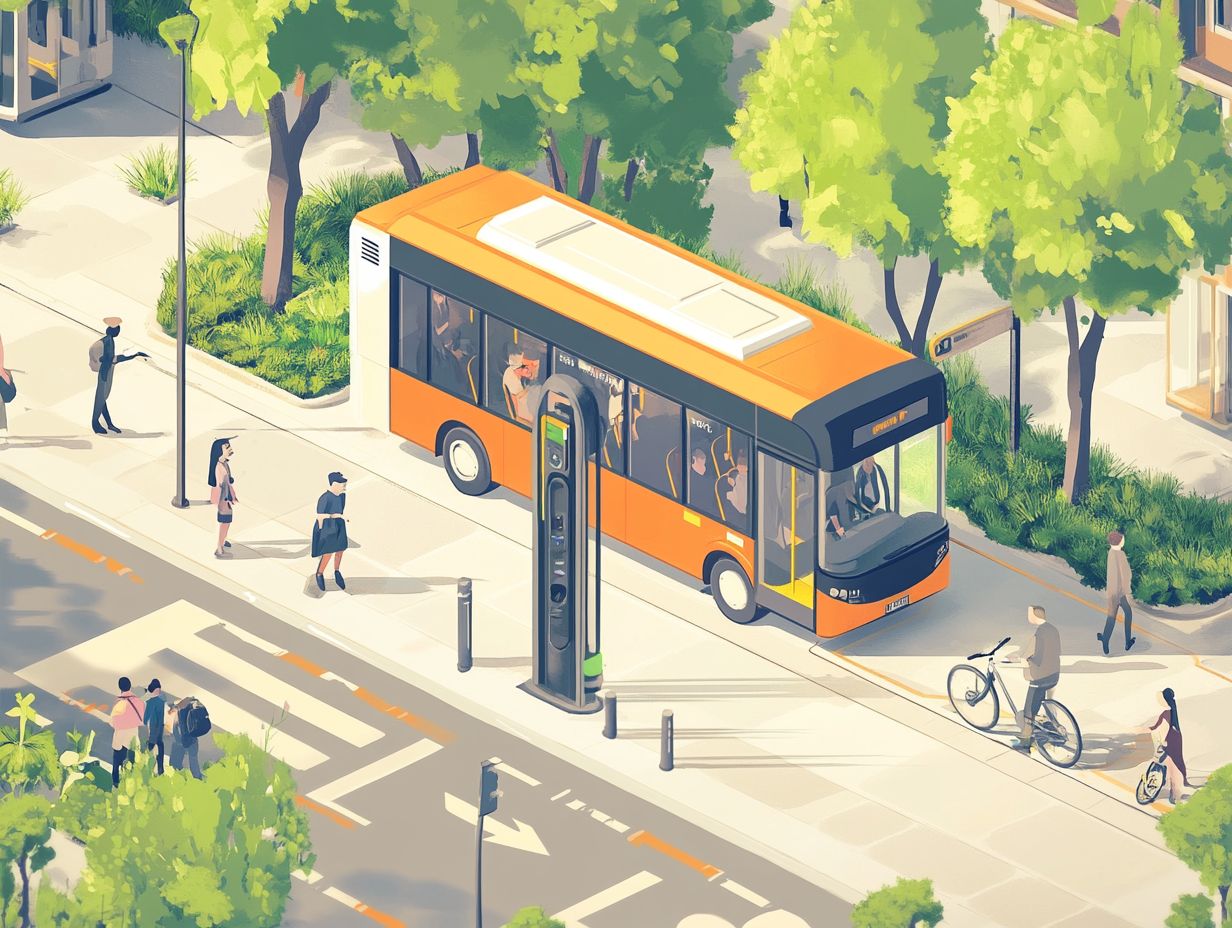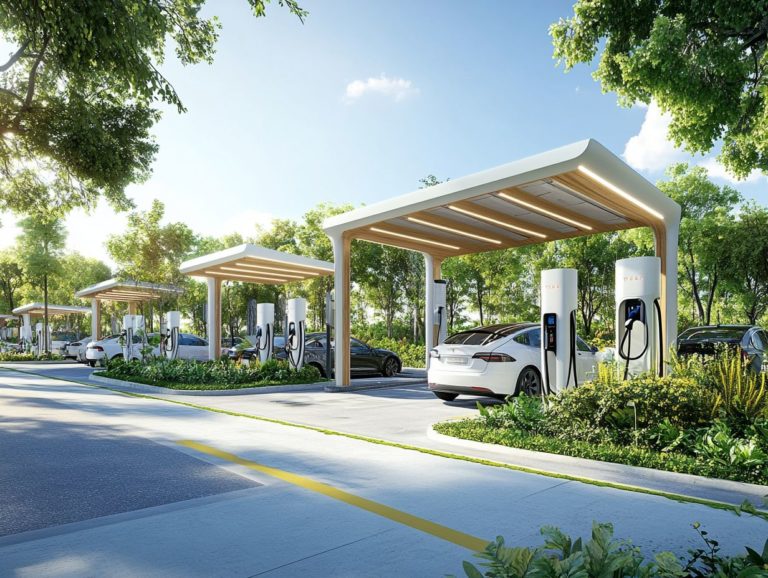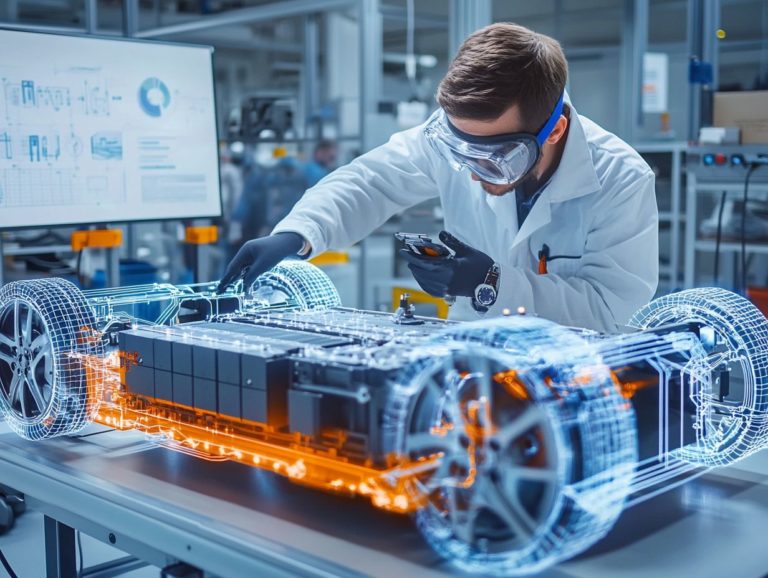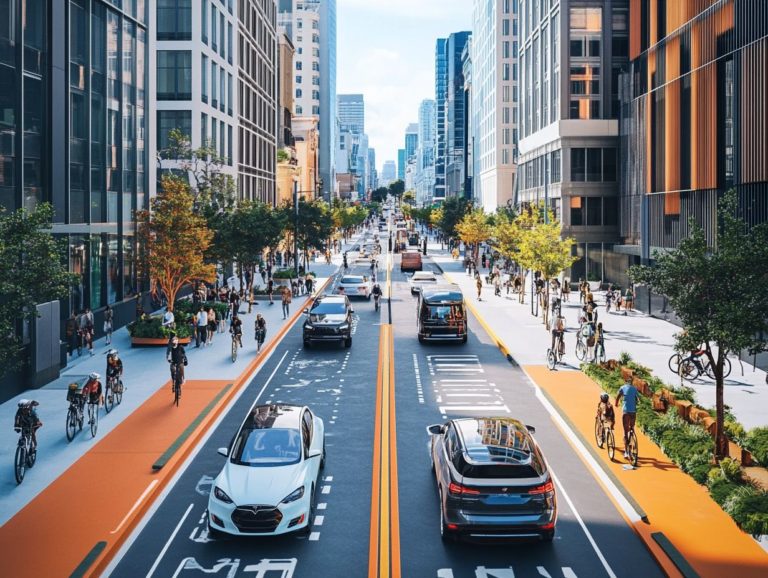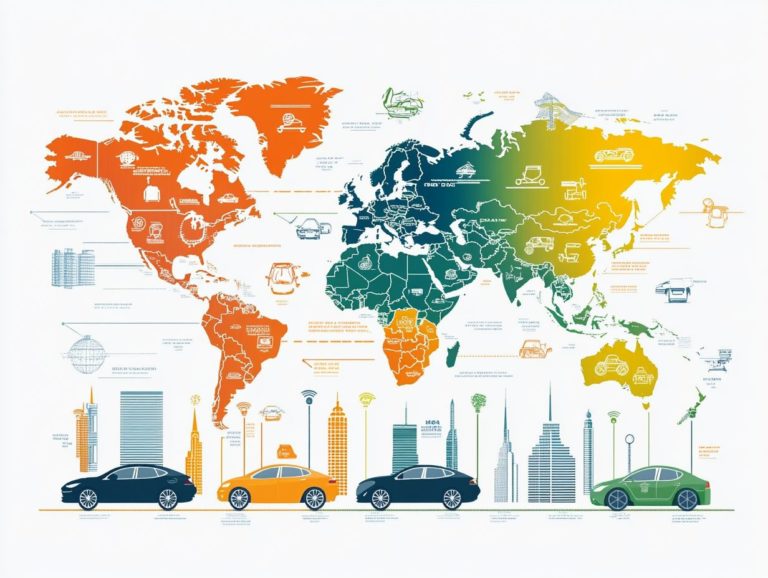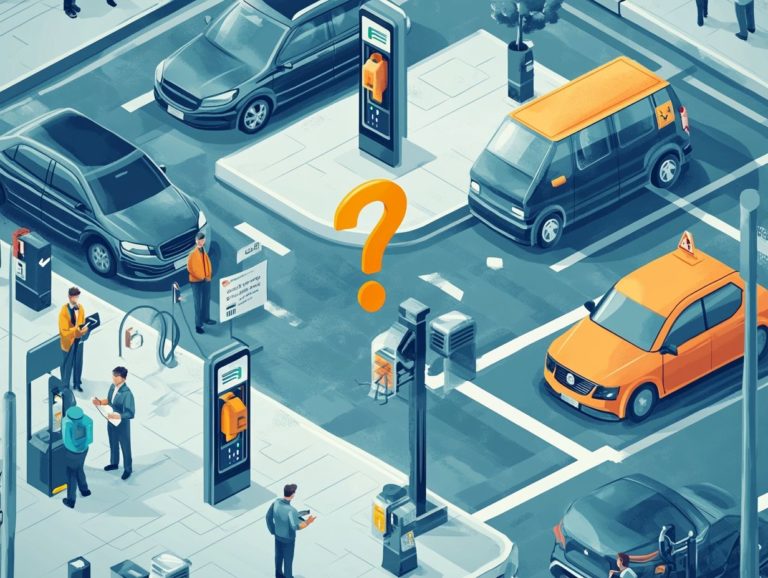The Future of EVs in Public Transportation
Electric vehicles (EVs) are revolutionizing the public transportation landscape, presenting a cleaner and more efficient alternative to traditional diesel-powered buses and taxis. Join us now as we dive into the future of urban mobility!
As you navigate the challenges of pollution and congestion in urban areas, the adoption of EVs within public transit systems is steadily gaining traction. This article delves into the current state of EVs in public transportation, exploring adoption rates, environmental benefits, and the hurdles related to infrastructure and technology.
You ll discover successful case studies that showcase effective implementations while contemplating the future of this crucial transformation in urban mobility. Embark on this journey as you explore the path toward sustainable public transport solutions.
Contents
- Key Takeaways:
- What are EVs and How are They Used in Public Transportation?
- Current State of EVs in Public Transportation
- Benefits of EVs in Public Transportation
- Barriers to Widespread Adoption
- Future Outlook for EVs in Public Transportation
- Predictions and Potential Solutions
- Case Studies of Successful Implementations
- Frequently Asked Questions
- What is the current status of EVs in public transportation?
- How will the adoption of EVs in public transportation impact the environment?
- Are there any challenges in implementing EVs in public transportation systems?
- What are the benefits of using EVs in public transportation for cities?
- Will EVs completely replace traditional vehicles in public transportation?
- What can governments and city planners do to encourage the use of EVs in public transportation?
Key Takeaways:

- Electric vehicles (EVs) are used in public transportation to reduce emissions and lower costs.
They have the potential to revolutionize public transportation by providing a more sustainable and cost-effective option. - Despite their benefits, widespread adoption of EVs in public transportation faces barriers like infrastructure and technology issues.
Addressing these challenges is crucial for the future success of EVs in public transportation. - Exciting developments in EVs promise a bright future for public transport!
Continued efforts to improve infrastructure and technology will support the growth of EVs in public transportation.
What are EVs and How are They Used in Public Transportation?
Electric vehicles (EVs) signify a remarkable advancement in urban transportation. They greatly enhance the effectiveness of public transport systems through the integration of new technologies and sustainable practices.
These vehicles, especially electric buses, are becoming central to contemporary mobility trends, offering cleaner alternatives to traditional diesel buses. Cities such as Barcelona, Madrid, and Los Angeles embrace these innovations to tackle pollution while laying the groundwork for a greener future, ensuring better air quality and a reduced carbon footprint.
Current State of EVs in Public Transportation
The current landscape of electric vehicles (EVs) in public transportation presents a significant transformation. Cities globally are increasingly adopting this technology, as highlighted in the future of electric vehicles in sustainable cities, to tackle mobility challenges and enhance public transport efficiency.
You will see different adoption rates in various regions, from cities in Sweden to initiatives led by the Rhode Island Public Transport Authority. The electric vehicle market is thriving, showcasing a diverse lineup of electric buses and even driverless electric buses, designed to meet the unique needs of urban environments.
Adoption Rates and Challenges
Adoption rates of electric vehicles in public transportation depend on various factors, including new technologies, financial incentives, and environmental considerations. However, there are significant challenges like maintenance costs and infrastructure limitations.
While cities like Badajoz and Pamplona lead this movement, many still struggle with the initial investments required to shift towards a sustainable electric vehicle market. Local government policies greatly affect this changing landscape by providing tax breaks and rebates to encourage fleet operators to invest in electric buses and trucks.
For instance, Los Angeles has developed a strategic infrastructure that includes an extensive network of charging stations, simplifying the integration of EVs into public transport systems. However, logistics companies often encounter financial hurdles, particularly with the upfront capital needed to purchase electric fleets, which can deter long-term commitment.
In urban areas with growing populations, there s a pressing need to balance improving air quality with the economic viability of transitioning public transport systems. While some cities serve as shining examples of EV adoption, many grapple with the intricate challenges of evolving their transportation frameworks.
Consider getting involved in sustainable transport initiatives to help shape the future of public transportation!
Benefits of EVs in Public Transportation
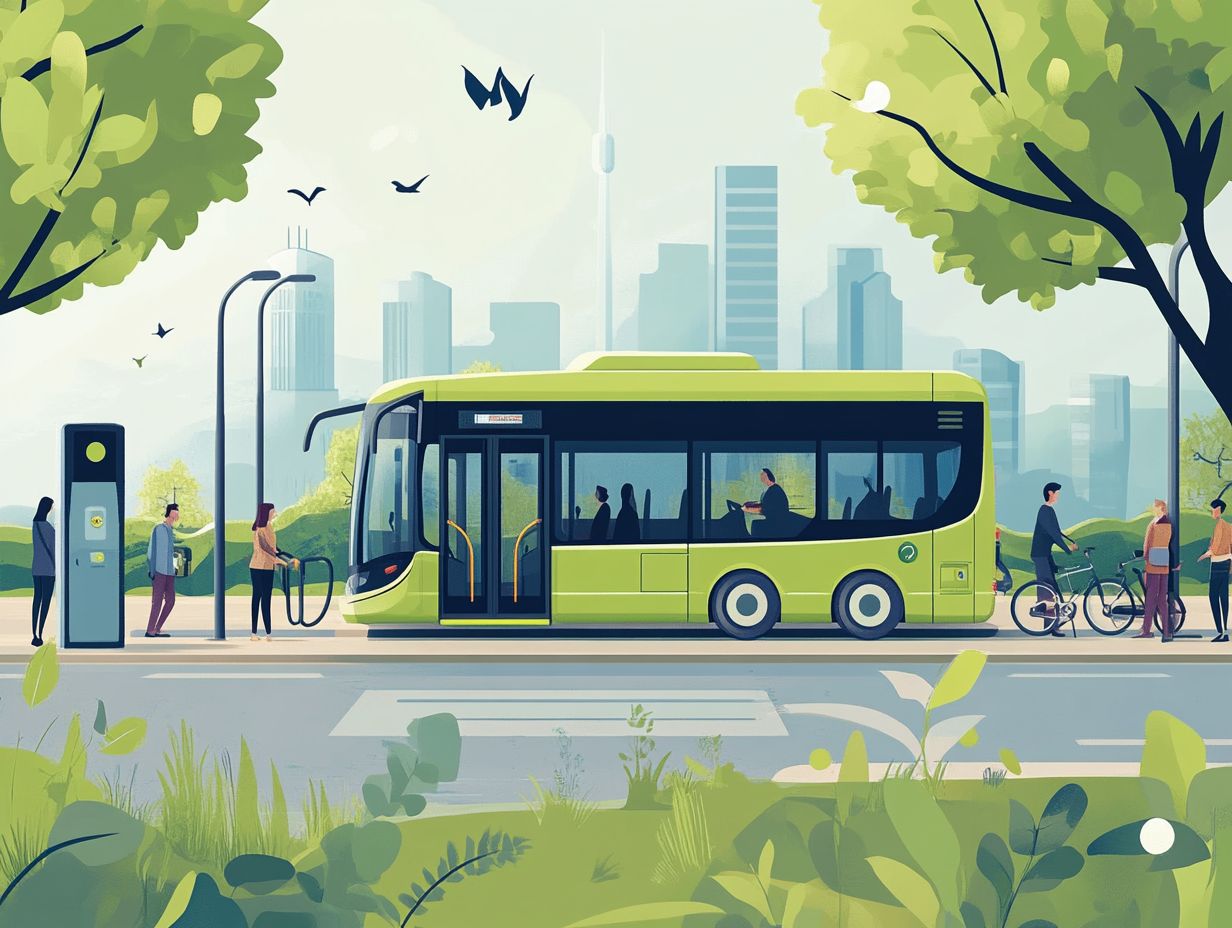
Electric vehicles in public transportation offer many advantages that extend beyond simple cost savings. They significantly impact the environment and urban living.
By introducing clean air buses, cities can reduce their greenhouse gas emissions, leading to improved air quality and a sustainable transportation option. This aligns with modern green transport initiatives.
The shift to electric buses addresses pollution concerns and enhances the overall efficiency of public transport systems, creating a better commuting experience.
Environmental Impact and Cost Savings
The environmental benefits of electric buses are transformative, leading to cleaner cities and a dramatic reduction in greenhouse gas emissions compared to traditional fuel sources.
Additionally, the cost savings related to the maintenance and operation of electric vehicles make a strong case for cities to adopt sustainable mobility solutions.
When municipalities switch to electric buses, they see a decrease in harmful pollutants and a noticeable improvement in air quality, which benefits public health. These buses operate more quietly, reducing noise pollution and creating a more enjoyable urban experience.
From a financial perspective, electric vehicles require less frequent servicing due to simpler mechanics, resulting in lower long-term maintenance costs. With available grants and incentives for adopting electric vehicles, the initial investment becomes manageable, paving the way for significant savings for public transport agencies.
Barriers to Widespread Adoption
Despite the compelling benefits of electric vehicles for public transportation, several barriers hinder widespread adoption. These primarily relate to infrastructure and technological limitations.
The lack of sufficient electric highways and charging stations poses a significant challenge for cities aiming to transition their fleets to electric buses, particularly driverless models that symbolize the future of sustainable transport.
Infrastructure and Technology Limitations
Infrastructure and technology limitations impact the challenges faced in implementing electric vehicles in public transportation. This includes the lack of charging stations and electric highways. Cities like Manchester and Newcastle are making progress, but technological advancements must accelerate to meet the growing demand for electric buses.
Without a comprehensive network of charging stations, operators and consumers may hesitate to adopt electric solutions. While various initiatives are in progress, many urban areas still deal with outdated road networks that cannot support heavier electric vehicles.
Disparities in investment across different regions can lead to varied adoption rates. For example, San Francisco has been proactive in rolling out integrated charging solutions.
To promote widespread acceptance, authorities must focus on expanding infrastructure and ensuring that the technological framework can adequately support increased usage.
Future Outlook for EVs in Public Transportation
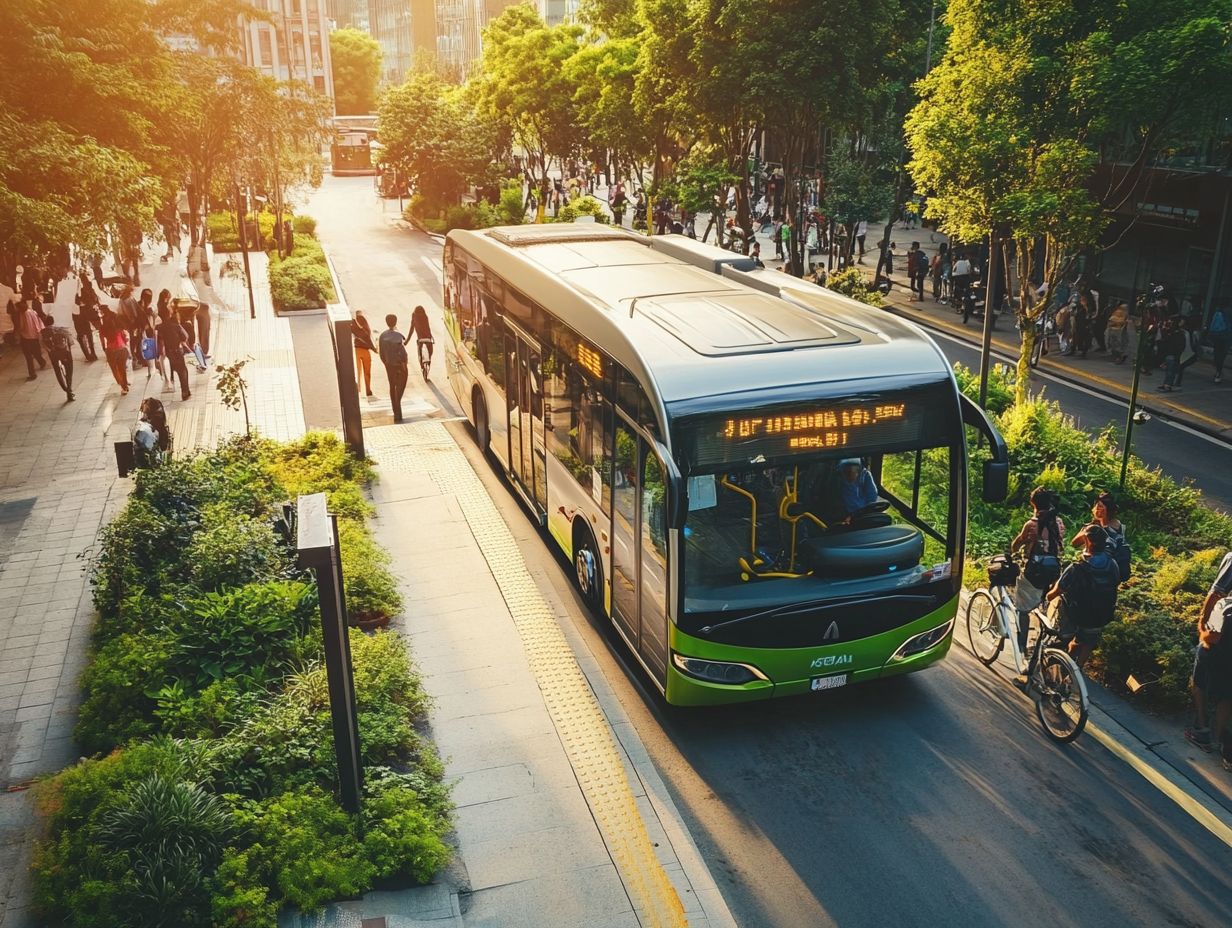
The future of electric vehicles in public transportation is promising, driven by remarkable technological advancements and a commitment to EV sustainability solutions.
As the electric vehicle market evolves, cities worldwide are expected to adopt electric buses more widely, integrating them into their public transport systems to address mobility trends and environmental challenges. Exploring the role of electric vehicles in sustainable transportation may give us insight into what a cleaner city could look like.
As we move forward, it s crucial to stay engaged and advocate for the adoption of electric vehicles in public transportation.
Predictions and Potential Solutions
Predictions for the electric vehicle market in public transportation indicate a significant increase in how many people are using electric vehicles, driven by innovative solutions and sustainable transport initiatives. Cities like Qinhuangdao are implementing comprehensive strategies, setting benchmarks for global practices in deploying electric buses and enhancing urban mobility.
Advancements such as wireless charging technology and fast-charging infrastructure aim to alleviate the worry about running out of battery, making electric buses a more appealing choice for your transit needs.
Policy changes focused on reducing carbon emissions and promoting energy-efficient public transport will be crucial. Take Los Angeles; they ve committed to transitioning their fleets to zero-emission vehicles by 2030. This exemplifies a dedication to environmental sustainability that could inspire similar actions in other cities.
Collaborations between governmental bodies and private enterprises could expedite the rollout of electric vehicle networks, transforming public transportation into a greener and more accessible option for all.
Case Studies of Successful Implementations
Examining case studies of successful electric vehicle implementations in public transportation offers valuable insights for future initiatives across various cities. For instance, Barcelona’s extensive network of electric buses and Madrid’s dedication to cleaner public transport systems highlight the transformative potential of integrating electric vehicles into urban mobility frameworks.
These initiatives enhance sustainability and set a standard for cities seeking to innovate and improve their public transport offerings.
Examples of Cities and Companies Leading the Way
Cities and companies leading the electric vehicle adoption in public transportation include shining examples like Barcelona, which has established a comprehensive network of electric buses. Companies such as Go Ahead are redefining sustainable transport practices, providing essential blueprints for urban areas looking to elevate their public transport systems.
Beyond Barcelona, cities like Los Angeles are making strides by introducing fleets of electric buses to reduce greenhouse gas emissions and improve air quality. Los Angeles Metro’s strategy revolves around advanced battery technology, allowing these buses to operate efficiently across extended routes.
Meanwhile, Transport for London (TfL) has woven electric buses into its extensive transport network, utilizing a mix of overhead charging systems and depots with rapid charging infrastructure. These initiatives significantly decrease urban pollution levels and demonstrate how collaboration between municipal governments and transport companies can pave the way for a more sustainable future in public transit.
Watch this video to learn more about the future of electric vehicles in public transport.
Frequently Asked Questions
What is the current status of EVs in public transportation?
Currently, EVs make up a small percentage of public transportation vehicles. However, with the increasing demand for sustainable transportation options, the future of sustainable mobility and electric vehicles is expected to see significant growth in their popularity in the near future.
How will the adoption of EVs in public transportation impact the environment?
The use of EVs in public transportation can greatly reduce greenhouse gas emissions and improve air quality, positively impacting the environment and making cities cleaner and more sustainable.
Are there any challenges in implementing EVs in public transportation systems?
One of the main challenges is the infrastructure needed to support EVs, including charging stations. The initial cost of purchasing electric vehicles may also be higher than traditional diesel or gas-powered buses.
What are the benefits of using EVs in public transportation for cities?
Along with reducing emissions, EVs can help decrease noise pollution in cities. They also have lower operating costs and require less maintenance compared to traditional vehicles, helping cities save money in the long run.
Will EVs completely replace traditional vehicles in public transportation?
It’s unlikely that electric vehicles (EVs) will fully replace traditional vehicles in public transportation.
However, as technology improves and cities focus on sustainability, the number of EVs in use is set to rise.
What can governments and city planners do to encourage the use of EVs in public transportation?
Governments should offer incentives and subsidies for buying EVs.
They can also invest in the necessary infrastructure.
City planners need to create policies that support EVs.
This includes prioritizing the development of charging stations.

